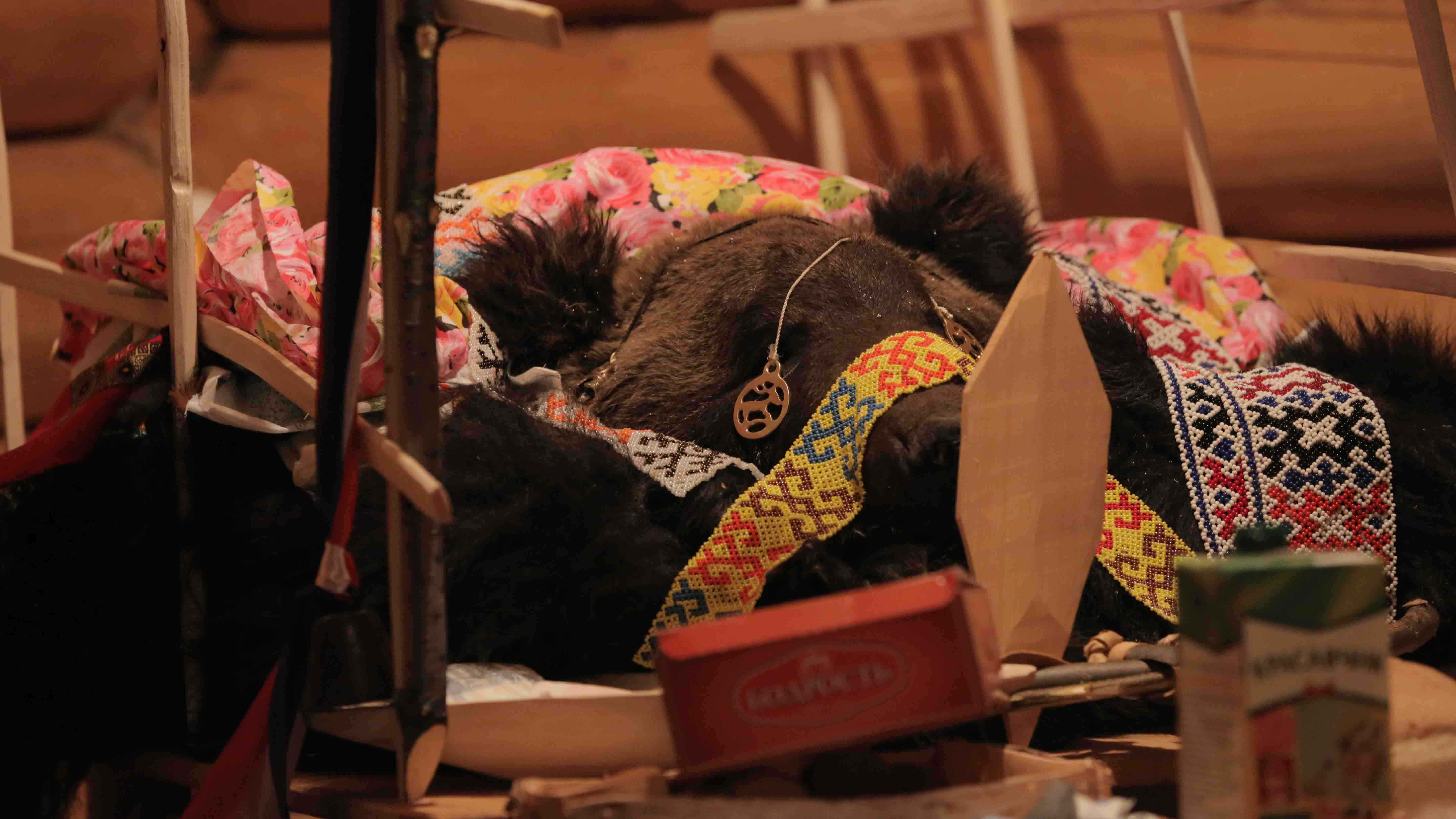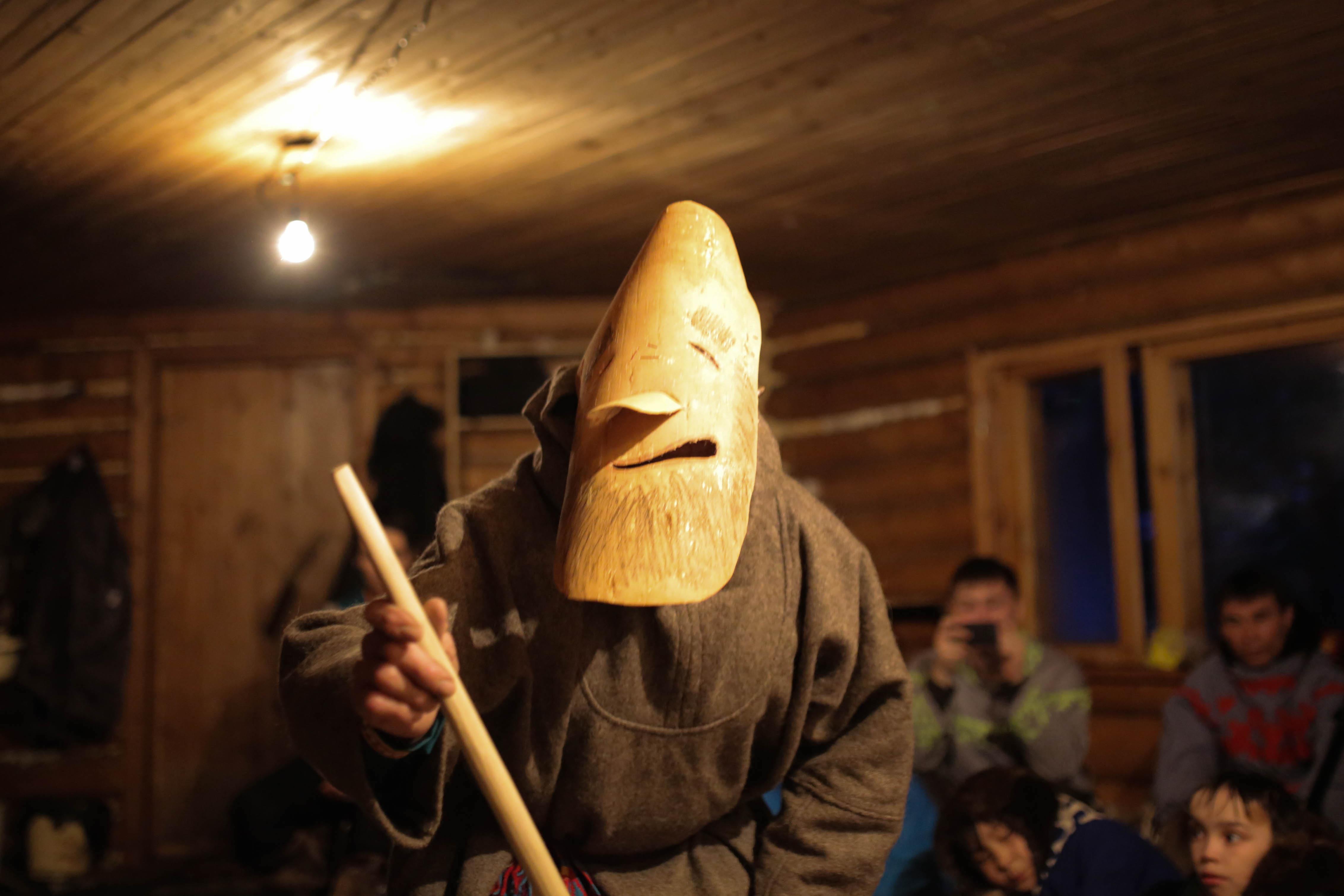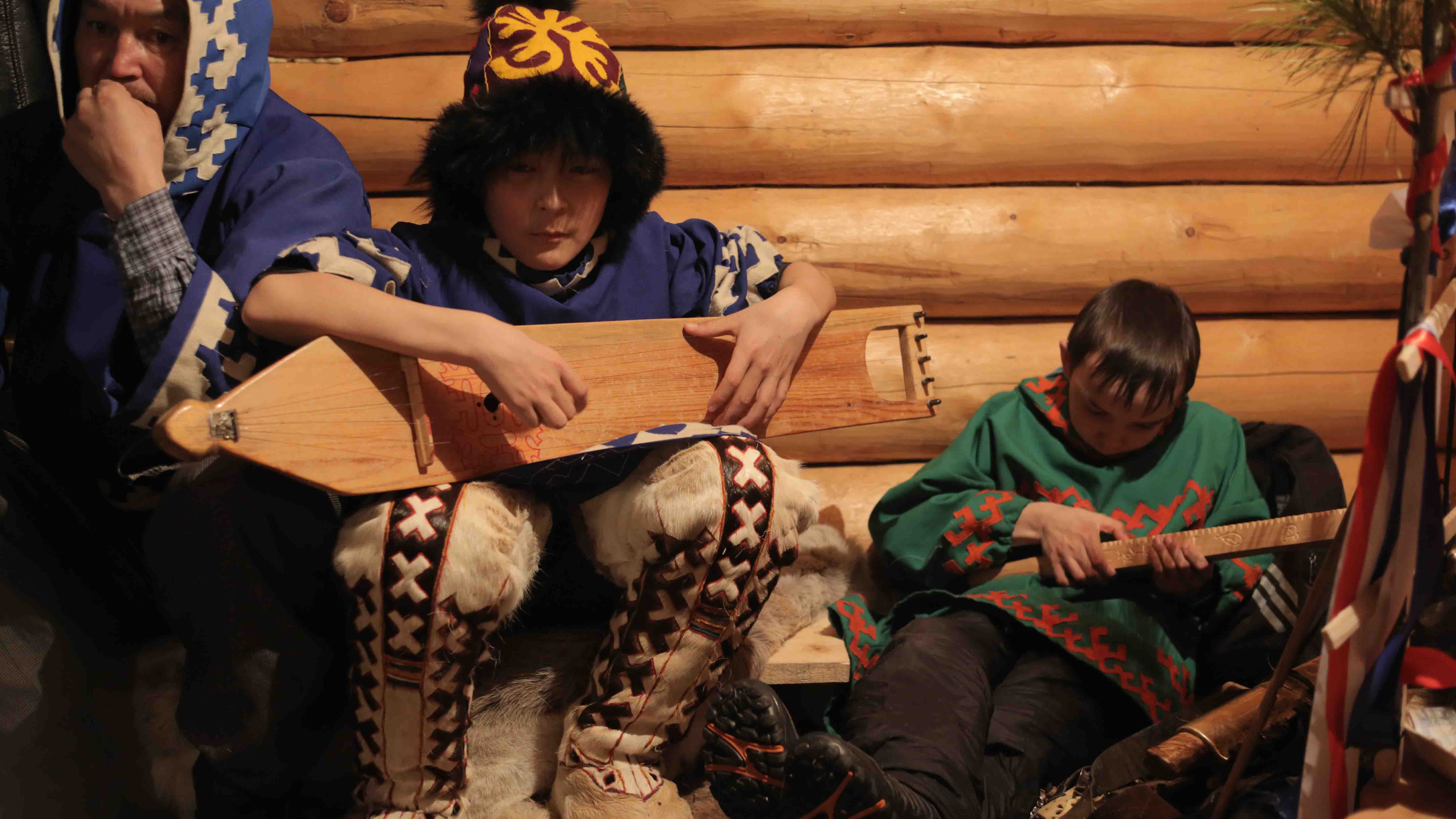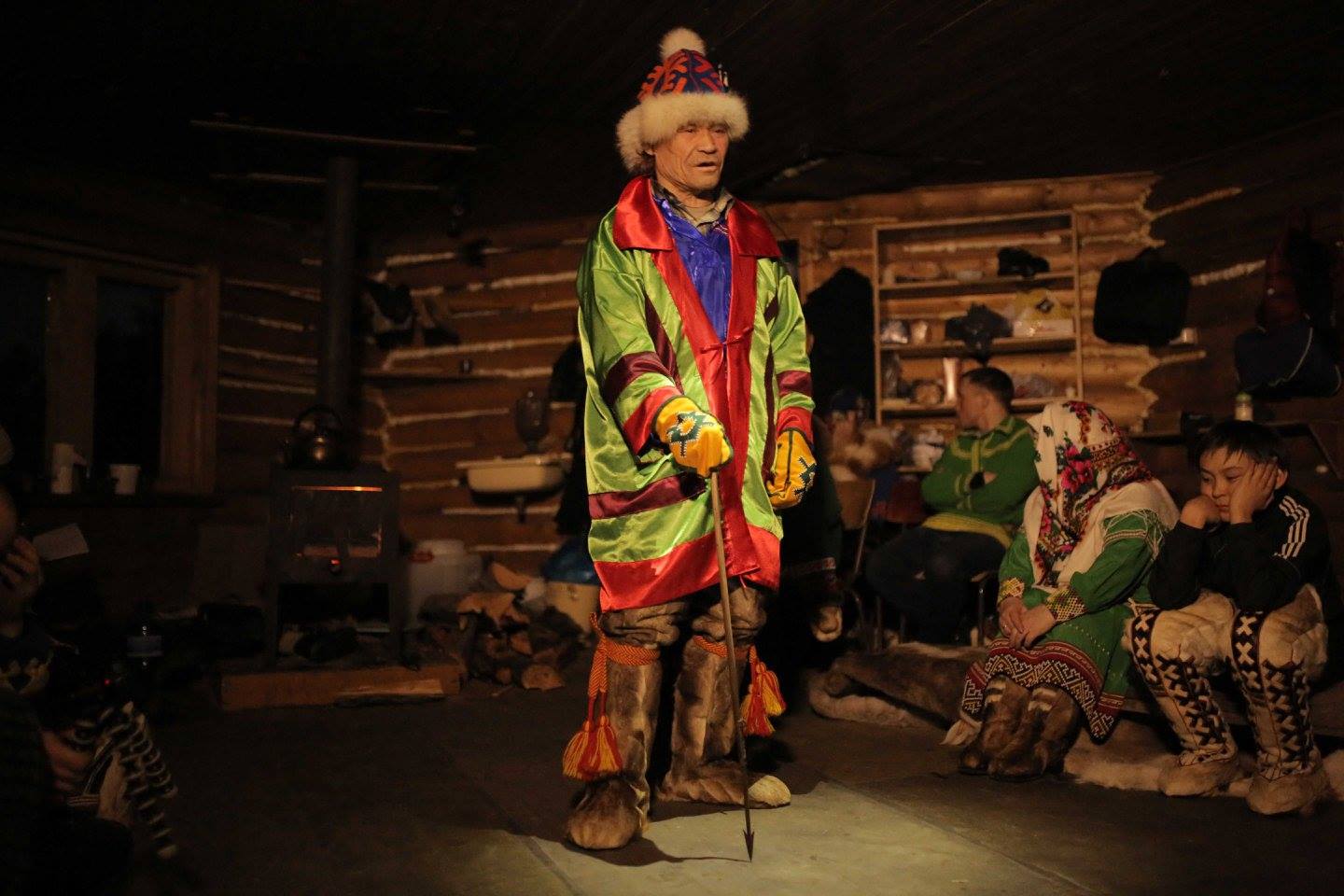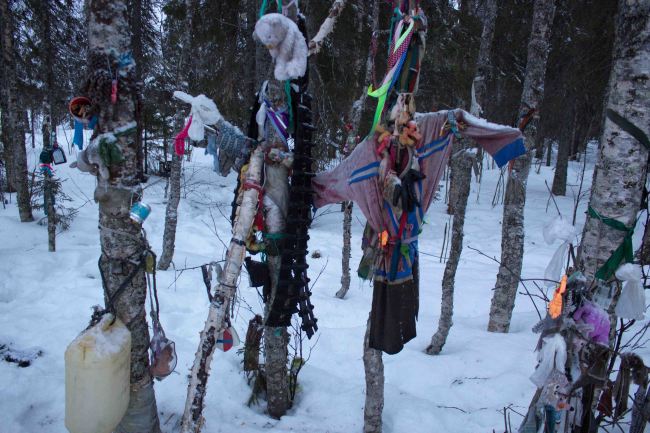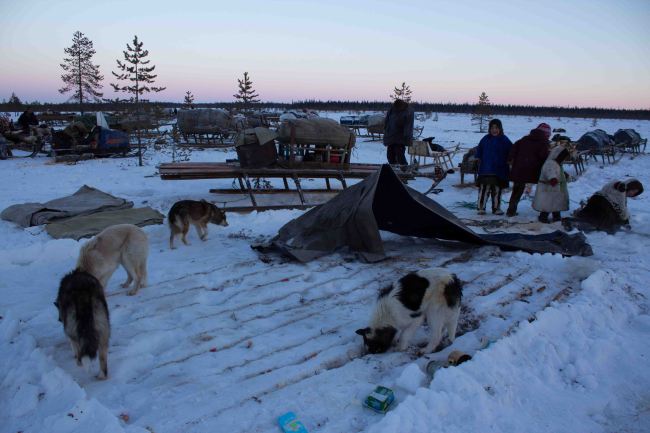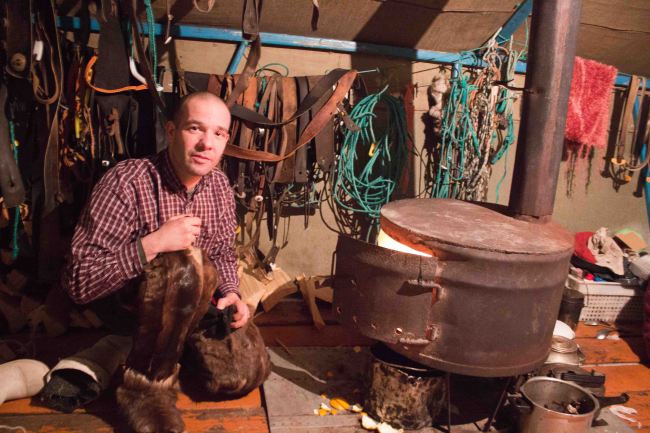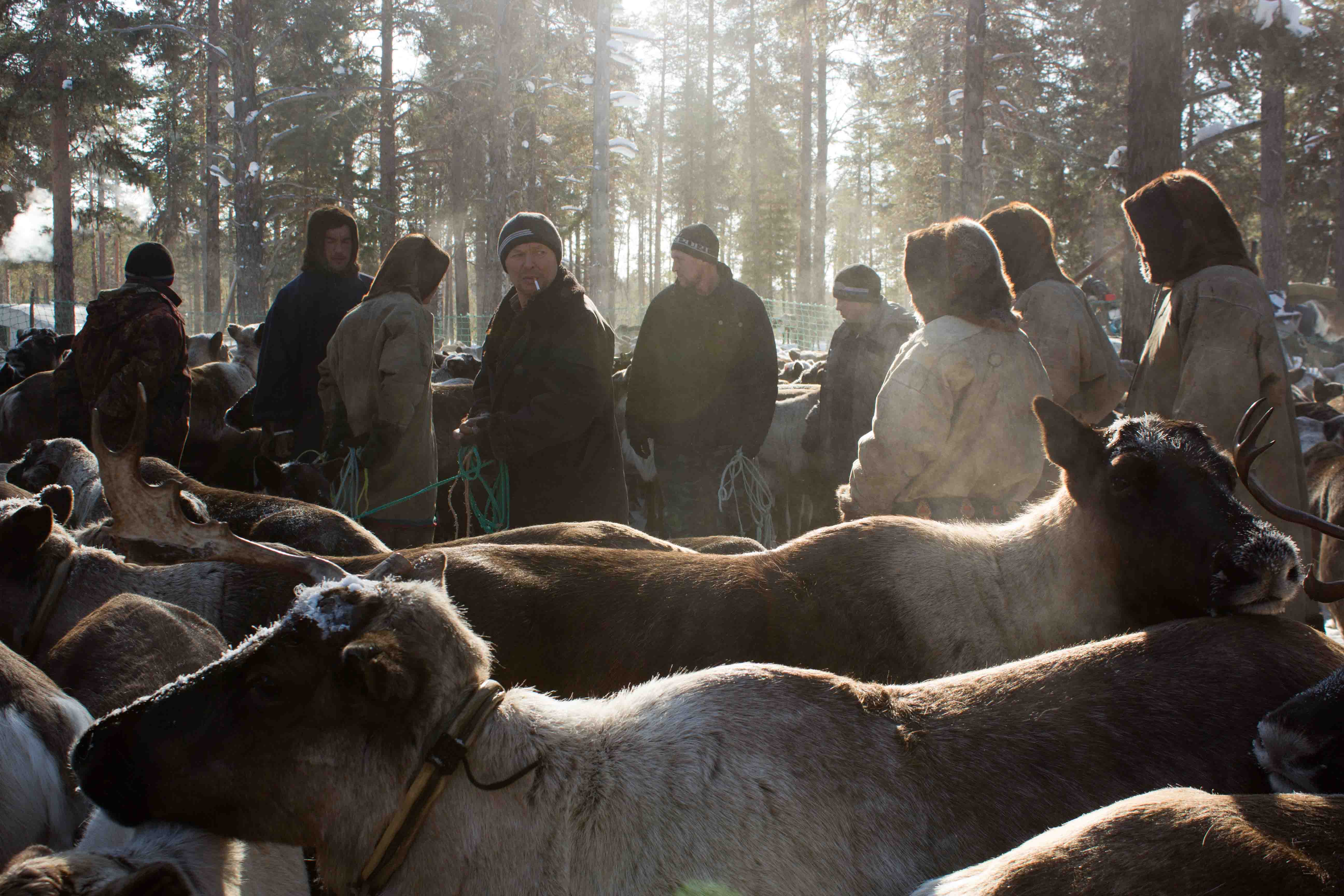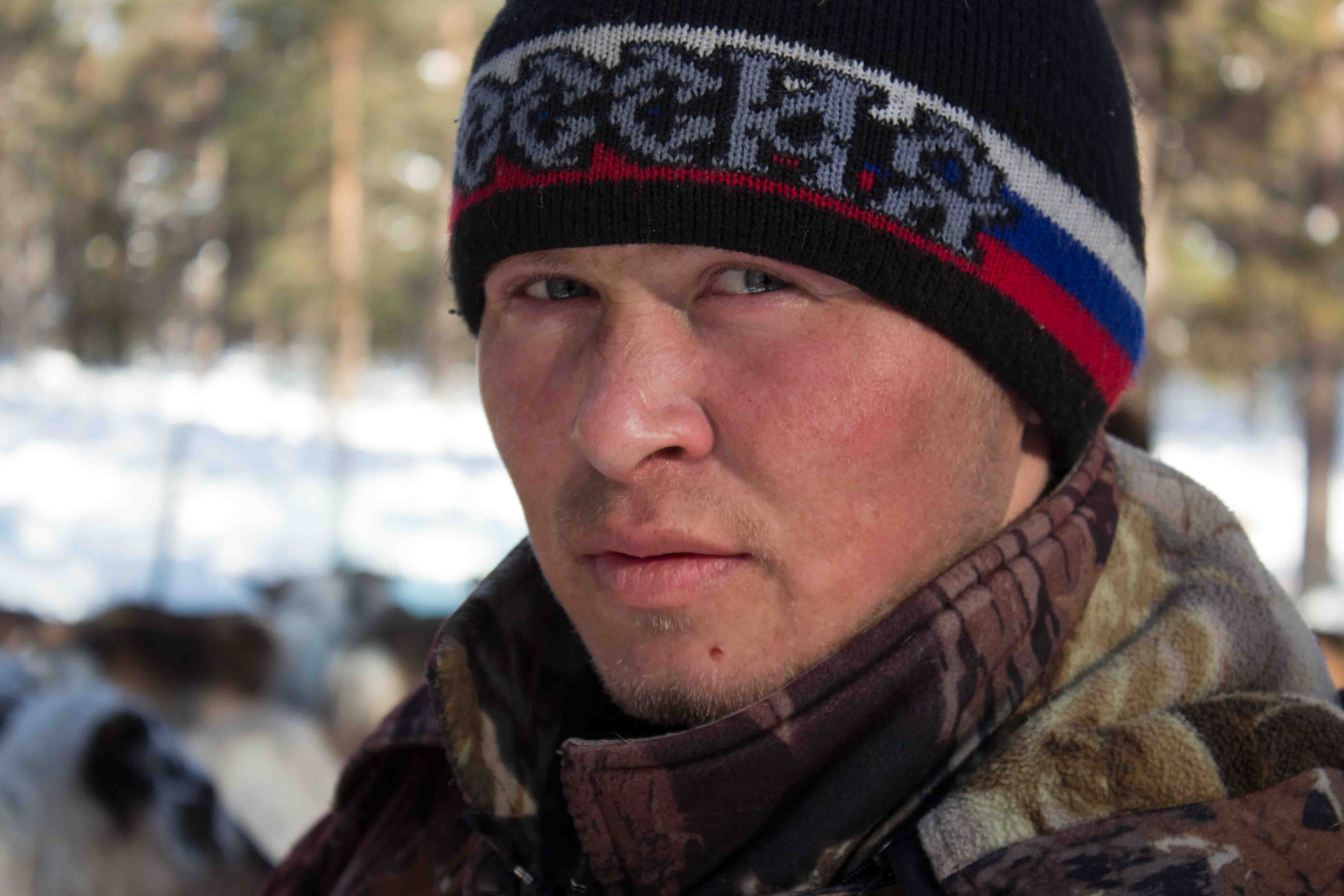In this blog entry, I want to tell the story of a wonderful journey I made recently with my friend and colleague Agrafena Semjonovna Sopochina and her daughter Marija Launonen through northern Finland and Norway, to Tallinn and to St. Petersburg during the second part of August 2016.

Agrafena, her daughter Marija and her grandson Edgars
Agrafena Sopochina visited Finland already in 1999 as member of a delegation of Khanty and Nenets taking part in the conference “Indigenous people and oil” (her presentation). She took part as well at the 2nd World Reindeer Herders’ Congress in Anar (Inari), in 2001. She is nowadays one of the most influential Khanty activists and author of most schoolbooks in the Surgut Khanty language.

Agrafena Semjonovna Sopochina (Pesikova)
For decades, she was running the Surgut Khanty folklore archive and collaborated with almost all researchers starting from Lennart Meri during his shootings of the “Sons of Torum” in 1985 and 1988. Agrafena is collaborating with me now on the unique recordings of the Surgut Khanty bear feast from 1985 and 1988 by Lennart Meri and myself in spring 2016. She is also assisting Sergei Kechimov (Сергей Васильевич Кечимов) the Khanty elder who is sued by Surgutneftegaz for defending the sacred lake of Imlor. There is plenty information about him and his case in the internet.

Inari Sámi Lesson
It was a long time plan I had to invite my friend Agrafena to Lapland to show her the beauty of that Arctic region. This way I wanted also to provide the possibility for her to meet local Sámi activists as well as reindeer herders. This kind of return visits become more and more an integrative part of anthropological research we are doing here in Anthropological Research Team at Arctic Centre. Taking the rules of reciprocity of our research partners seriously means to invite them to our private homes as well after they opened the doors not only to the public façade of their cultures but also to the everyday life of their families.

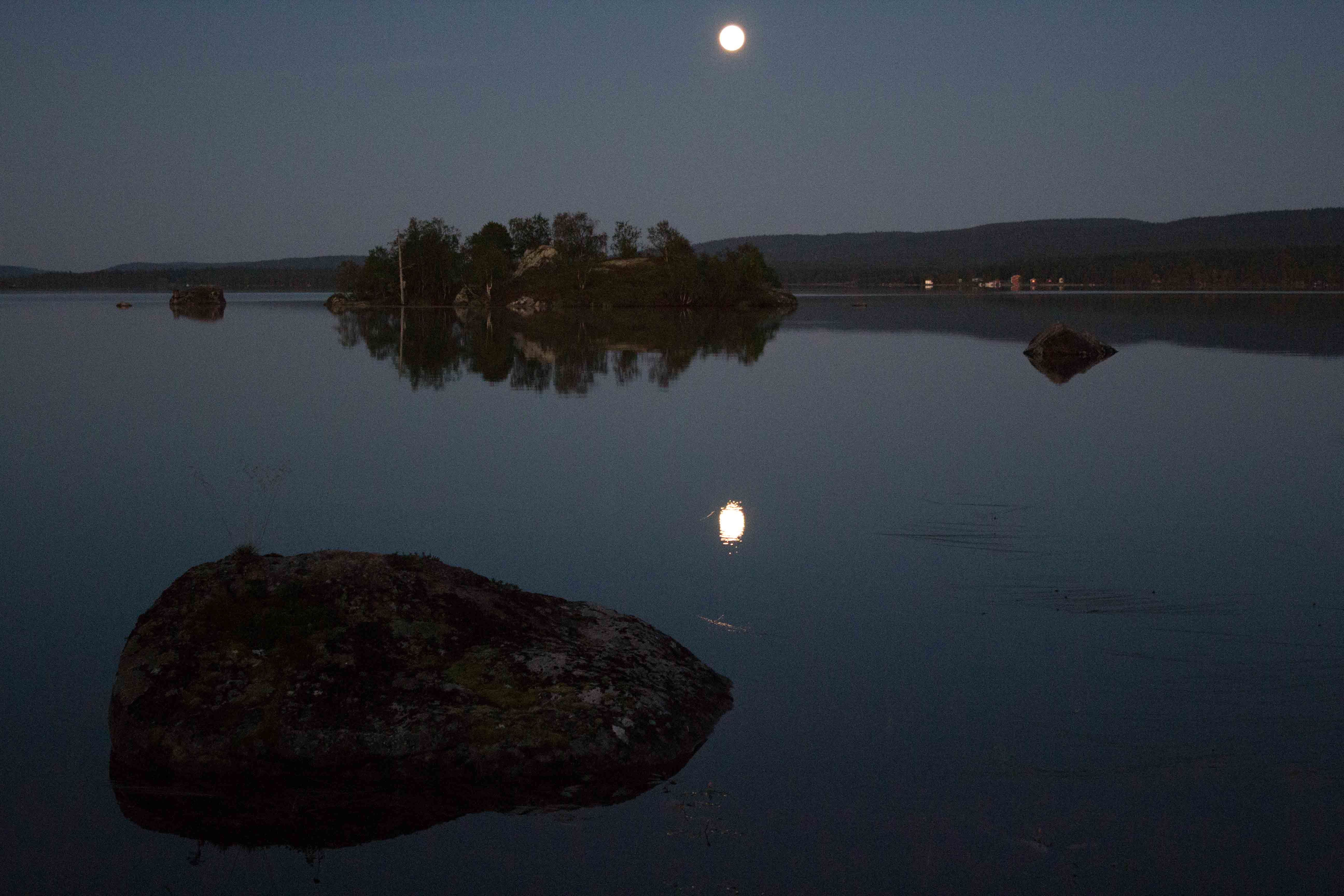
Lake Inari
Therefore, I had to host Agrafena and Marija at my home in Rovaniemi, take a tent and a car and wrote to a lot of Sámi institutions up north, that two Khanty and an anthropologist are ready to camp in their backyard or out on the fells, if they would be ready to meet us.

Agrafena Sopochina and Marina Falevitch
Immediately I received a call from Marina Falevitch from the Sámi Education Institute in Inari. She not only invited us to the wonderful dormitory at the shore of the Lake Inari, but also organised a three days full program for the Khanty guests. The generous hospitality of the Sámi Educational Institute was impressive and Marina spend all her working time and even her free time in order to let us feel like honourable guests in the Sámi community of Inari. Marina’s husband drove us to different Sámi enterprises in the vicinity and served self-caught and smoked fish from the Lake Inari. This was not the last time we encountered the great Sámi hospitality on our way north.

Learning Inari Sámi language
But back to the fulltime program in Inari. Thanks to Marina Falevitch we got a deep inside in all the educational activities among the Sámi in Inari. Agrafena mentioned that the Surgut Khanty could only dream about the achievements, that the Inari dialect has made in the last couple of years. The Surgut dialect of Khanty language is in a quite similar position being dominated by another not understandable dialect of a close group in the North – the Northern Khanty language. As the Inari Sámi, they would love to involve lay people and elders in the education of children and would like to have other school subjects than just the “mother tongue” taught in their own language.

Schoolbook in Sámi languae
Impressive and unique is also the position of the Sámi Education Institute for the development of traditional knowledge and crafts of the Sámi. There is nothing comparable in Western Siberia.
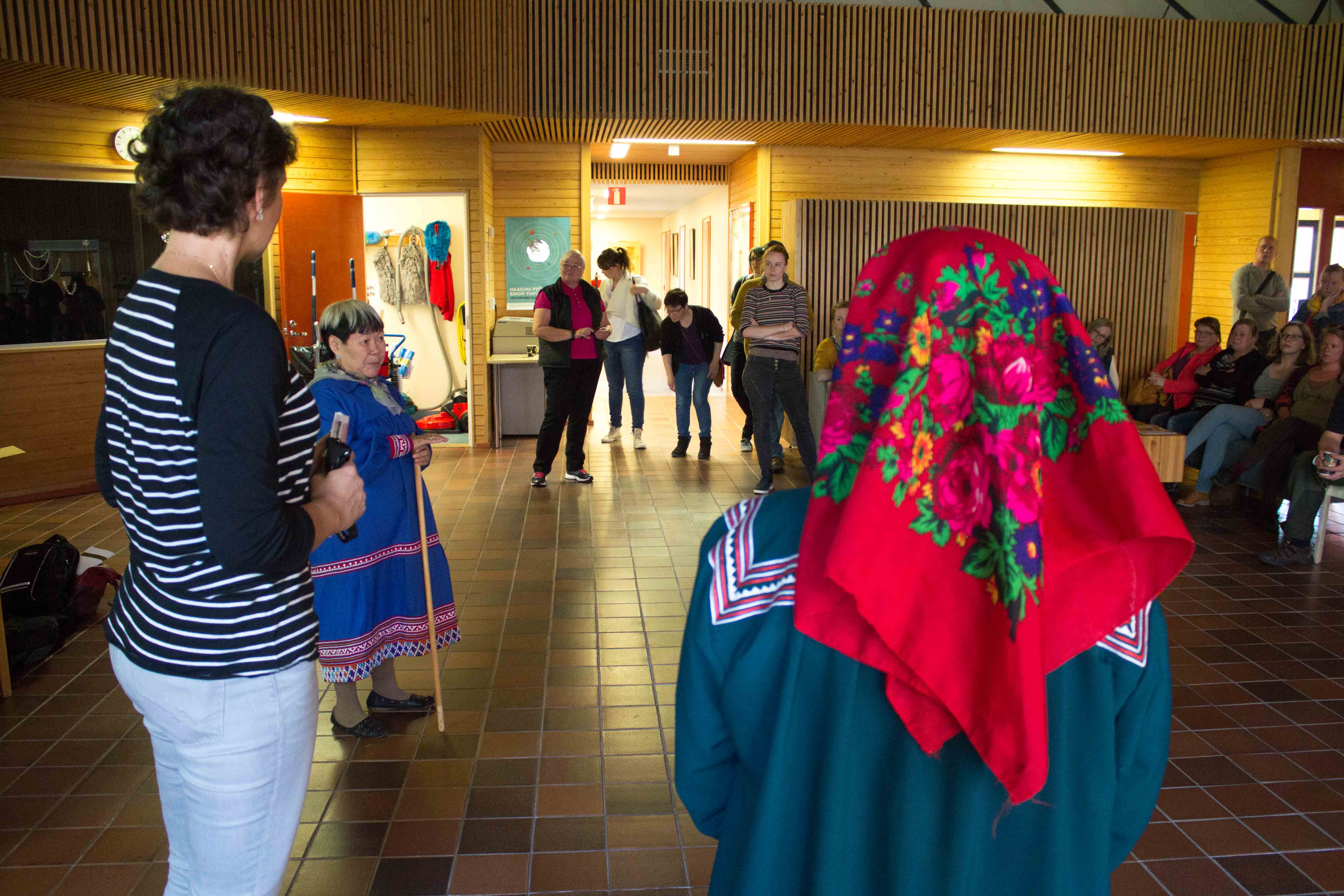
Agrafena gives a lecture at the institute
The slaughterhouse we visited in Toivoniemi made the differences even more palpable. Reindeer herding among the Khanty is far from being a meat producing business with strong regulations of slaughtering guaranteeing stable meat quality. Economic pressure rises the number of animals a herder should have in order to survive. Effectiveness of meat production demands big numbers – a logic that is (yet?) foreign to the Khanty.

In Toivoniemi

Smallscale slaughterhouse for reindeer
At the evening the leadership of the Sámi Educational Centre invited us to a wonderful dinner at restaurant Aanaar at the Kultahovi.
 Everybody was impressed, what the chefs were able to produce from local ingredients like reindeer lichen. But more important were the discussions about similar issues Sámi as well as Khanty are facing today. Liisa Holmberg told about the international cooperation on the protection of sacred sites. In Sápmi sacred sites are either long time known places partially turned already into tourism destinations, as the sacred island Ukkonsaari, we visited the next day. Or they are intimate places of worship known only to the family. Agrafena told about the vivid religious community rituals among the Khanty, but also about the religious, legal and political struggle ongoing between Khanty custodians of the sacred sites, oil-companies, protestant converts and state administrations. The degree of conflict but also of public religious activities among the Khanty differs a lot from the Sámi experiences, but the underlining logics are similar. We departed with the hope, that the future international cooperation on the issue will include also the Khanty cases of struggle for such important sacred places like Imlor, Numto or Shaman-Gora in the Surgut region.
Everybody was impressed, what the chefs were able to produce from local ingredients like reindeer lichen. But more important were the discussions about similar issues Sámi as well as Khanty are facing today. Liisa Holmberg told about the international cooperation on the protection of sacred sites. In Sápmi sacred sites are either long time known places partially turned already into tourism destinations, as the sacred island Ukkonsaari, we visited the next day. Or they are intimate places of worship known only to the family. Agrafena told about the vivid religious community rituals among the Khanty, but also about the religious, legal and political struggle ongoing between Khanty custodians of the sacred sites, oil-companies, protestant converts and state administrations. The degree of conflict but also of public religious activities among the Khanty differs a lot from the Sámi experiences, but the underlining logics are similar. We departed with the hope, that the future international cooperation on the issue will include also the Khanty cases of struggle for such important sacred places like Imlor, Numto or Shaman-Gora in the Surgut region.
 Probably the main purpose and highlight of the visit to Inari was a short but intensive visit of the material in the Sámi archive collected at the beginning of the 1990ies among the Surgut Khanty. These materials, like the ones that were recorded by Lennart Meri and preserved in Estonia, will hopefully return to the Khanty one day. But it is important that the efforts to make them available respect the ethics of knowledge distribution as well as access rules of the indigenous people they were collected from. We got the strong impression during our meeting with Inker-Anni Linkola and Ugnė Starkutė that here at the Sámi archive these principles are held in high esteem and it is one of the rare examples, where high quality archival work is combined with indigenous perspectives on knowledge transmission and information management.
Probably the main purpose and highlight of the visit to Inari was a short but intensive visit of the material in the Sámi archive collected at the beginning of the 1990ies among the Surgut Khanty. These materials, like the ones that were recorded by Lennart Meri and preserved in Estonia, will hopefully return to the Khanty one day. But it is important that the efforts to make them available respect the ethics of knowledge distribution as well as access rules of the indigenous people they were collected from. We got the strong impression during our meeting with Inker-Anni Linkola and Ugnė Starkutė that here at the Sámi archive these principles are held in high esteem and it is one of the rare examples, where high quality archival work is combined with indigenous perspectives on knowledge transmission and information management.
 Tourism and handicraft production for a touristic audience is nowadays an important part of Sámi livelihoods. The level of craftsmanship or better say craftswomanship is high as we were able to satisfy ourselves. Marina drove us to the gallery Kammi
Tourism and handicraft production for a touristic audience is nowadays an important part of Sámi livelihoods. The level of craftsmanship or better say craftswomanship is high as we were able to satisfy ourselves. Marina drove us to the gallery Kammi
 and to the studio of Kaja Paltto producing art, made of felt.
and to the studio of Kaja Paltto producing art, made of felt.
The third place was Ahkun Tupa, where we discussed the traditional Sámi dresses and their development. In comparison to the generations before, the dresses became much more colourful and ornamented, but they stopped being an everyday clothing.
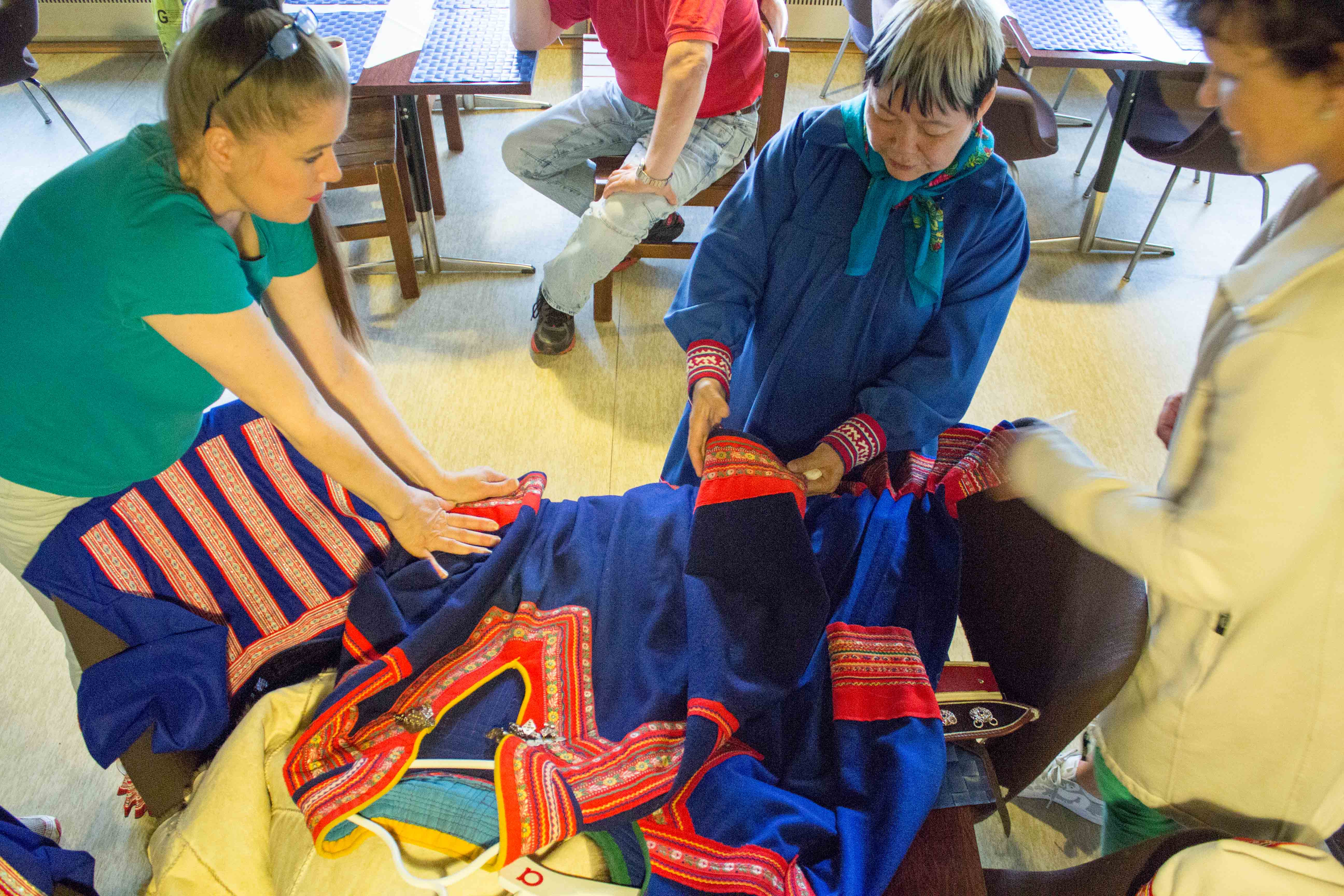 Whoever we met among the Sámi was amazed of the laboriously Khanty ornaments cut and sewn by hand without any technical tools.
Whoever we met among the Sámi was amazed of the laboriously Khanty ornaments cut and sewn by hand without any technical tools.
In the evening, we experienced again a presentation of local culinary skills – this time by graduates of the Sámi Education Institute in the Lassen-Kota of the college.
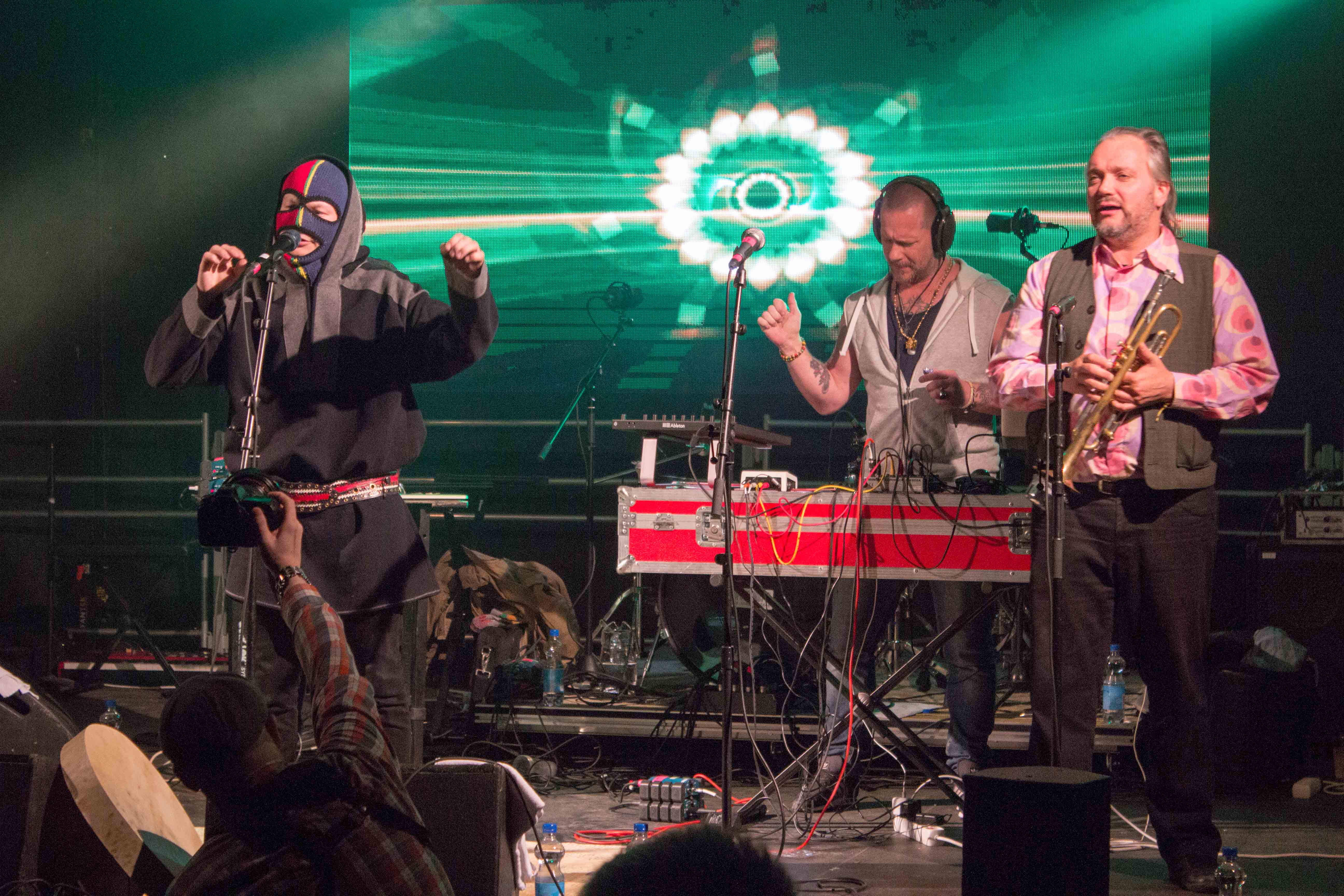 The day before we met already Sámi singer Nilas Holmberg at the hotel Kultahovi and he suggested us not to miss the concerts of the Sámi music festival “Ijahis idja”.
The day before we met already Sámi singer Nilas Holmberg at the hotel Kultahovi and he suggested us not to miss the concerts of the Sámi music festival “Ijahis idja”.
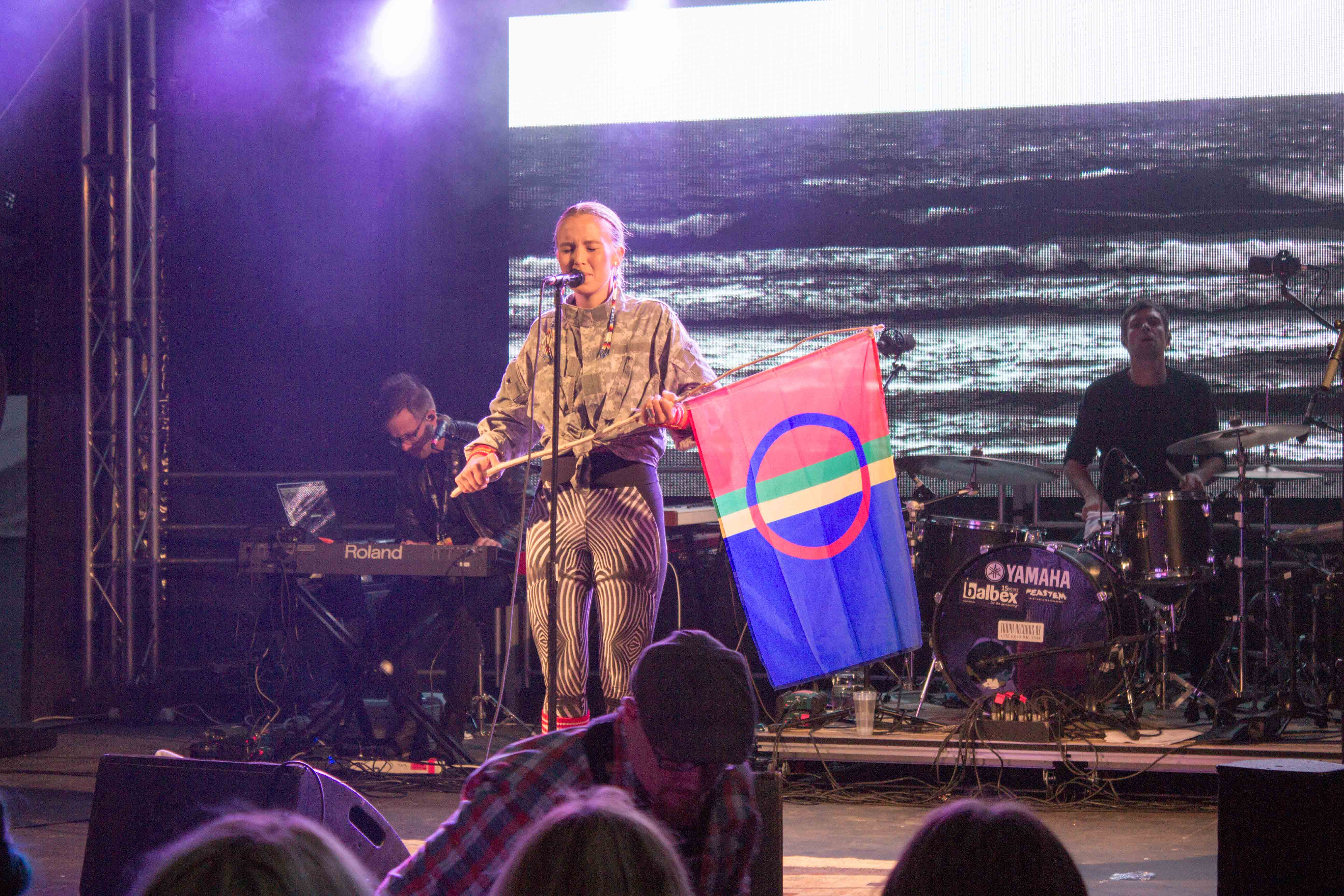 The highlight was of course Sofia Jannok, Sámi singer from Sweden. Waving the Sámi flag and wearing an army jacket underlined her performance as a straightforward statement for active and militant struggle for indigenous rights. She cited even the movie “Avatar” as a model for her perception of indigenous history.
The highlight was of course Sofia Jannok, Sámi singer from Sweden. Waving the Sámi flag and wearing an army jacket underlined her performance as a straightforward statement for active and militant struggle for indigenous rights. She cited even the movie “Avatar” as a model for her perception of indigenous history.
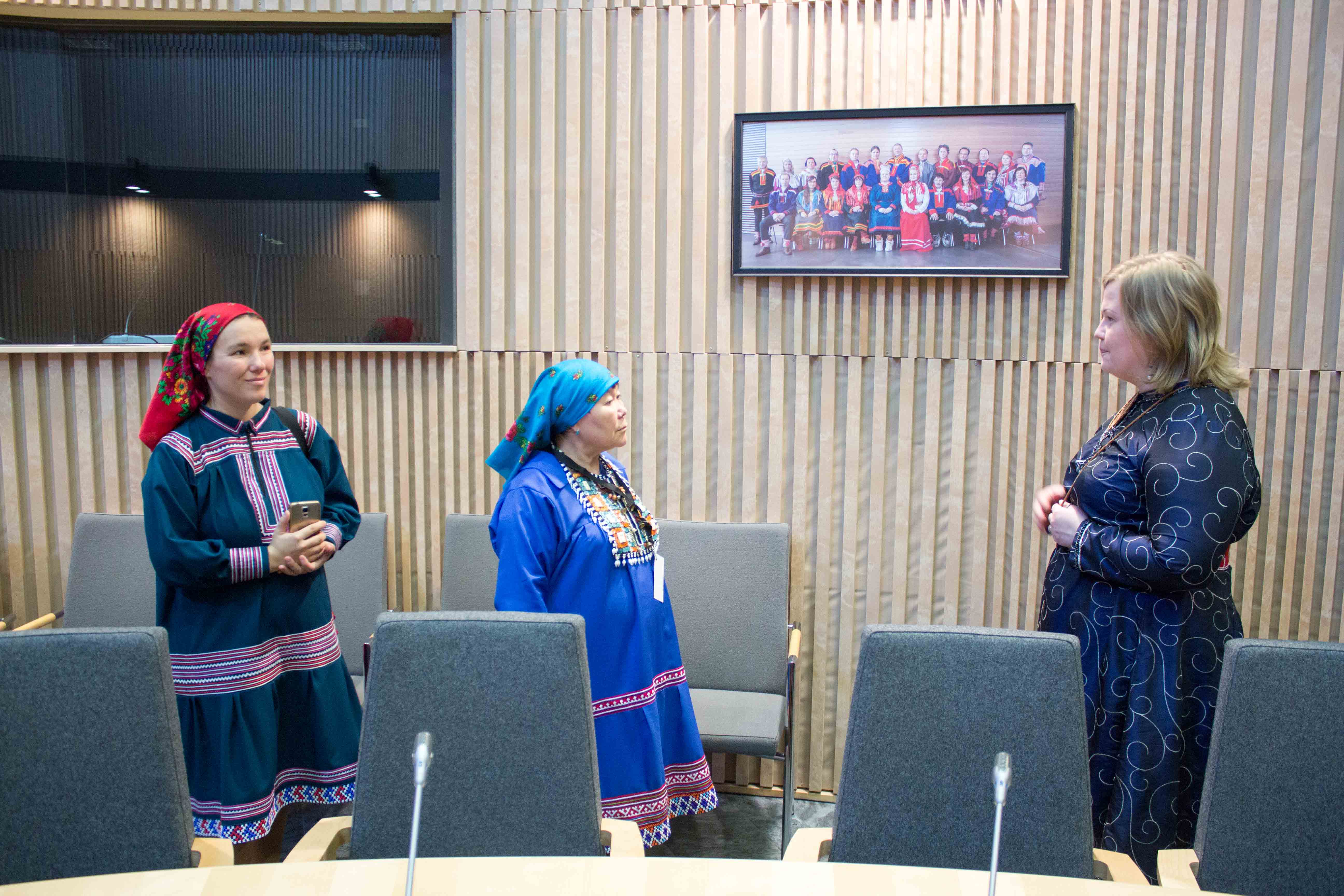 Next day we met the president of the Sámi parliament Tiina Juulia Sanila-Aikio or Skolt Sami: Paavvâl Taannâl Tiina.
Next day we met the president of the Sámi parliament Tiina Juulia Sanila-Aikio or Skolt Sami: Paavvâl Taannâl Tiina.
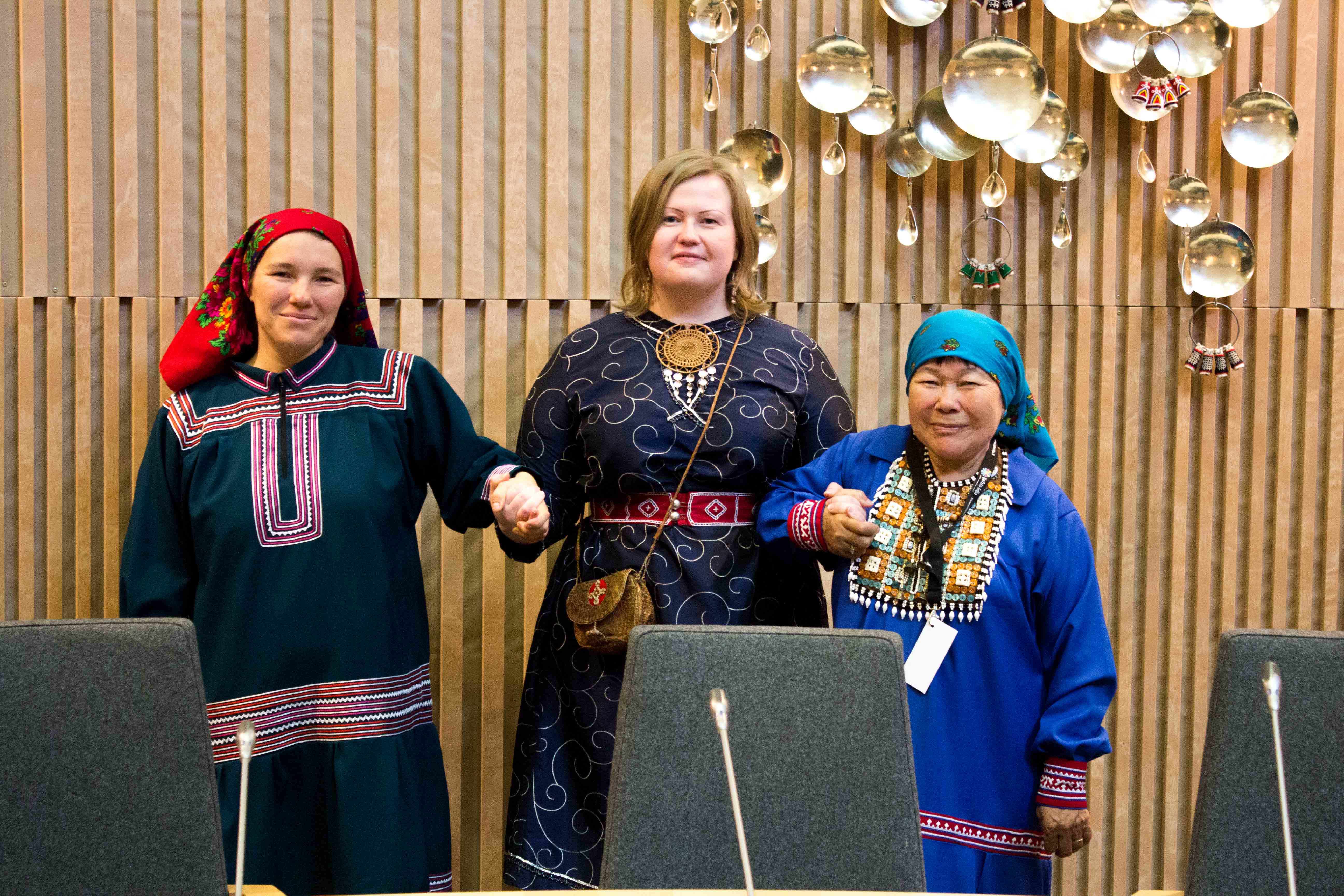 Maybe the title president implies to follow a protocol and a formalised way of meeting. This was not at all the case. At the opposite – the Sámi president is just a highly skilled professional on the issues the parliament is dealing with today.
Maybe the title president implies to follow a protocol and a formalised way of meeting. This was not at all the case. At the opposite – the Sámi president is just a highly skilled professional on the issues the parliament is dealing with today.
Agrafena and her daughter discussed very openly with her the functioning of the Sámi parliament, the topic of traditional music and rights to cultural traditions, for instance information on rituals and sacred places. They spoke about the question, if indigenous people should have property rights on their knowledge or should be the caretaker or custodians of that knowledge when the problem arise that the legal system has difficulties to acknowledge this kind of custodianship and care. The Khanty consider it more as a duty which oblige people to deal carefully with knowledge and use it in a proper way said Agrafena. There are other than human beings involved: animals, gods, spirits and the ancestors and private property rights of living humans might not be the best solution to deal with sacred places, traditional symbols and designs, with music or other performative arts from Agrafena’s perspective. When Tiina Sanila-Aikio brought us to the exhibition room Agrafena was overwhelmed of the variety in the collection of schoolbooks in Sámi languages.
When Tiina Sanila-Aikio brought us to the exhibition room Agrafena was overwhelmed of the variety in the collection of schoolbooks in Sámi languages.
In the evening Agrafena and her daughter presented Khanty music on the stage of the festival. Here some links to the”Ijahis idja” homepage in Finnish; Yle about Khanty guest in Finnish language and about the visit in Sámi language; about their performance in Sámi and Article in Sámi language about the festival.
Here some links to the”Ijahis idja” homepage in Finnish; Yle about Khanty guest in Finnish language and about the visit in Sámi language; about their performance in Sámi and Article in Sámi language about the festival.
After the performance Pekka Samalahti grand senieur of Sámi studies approached Agrafena, whom he remembered from her former visits to Finland. Agrafena met a kindred soul in the man who devoted all of his life to the study of a minority language just as she did as well.
 After their performance Marija and Agrafena gave a radio interview to Yle Areena in Skolt Sámi language.
After their performance Marija and Agrafena gave a radio interview to Yle Areena in Skolt Sámi language.
(to be continued)
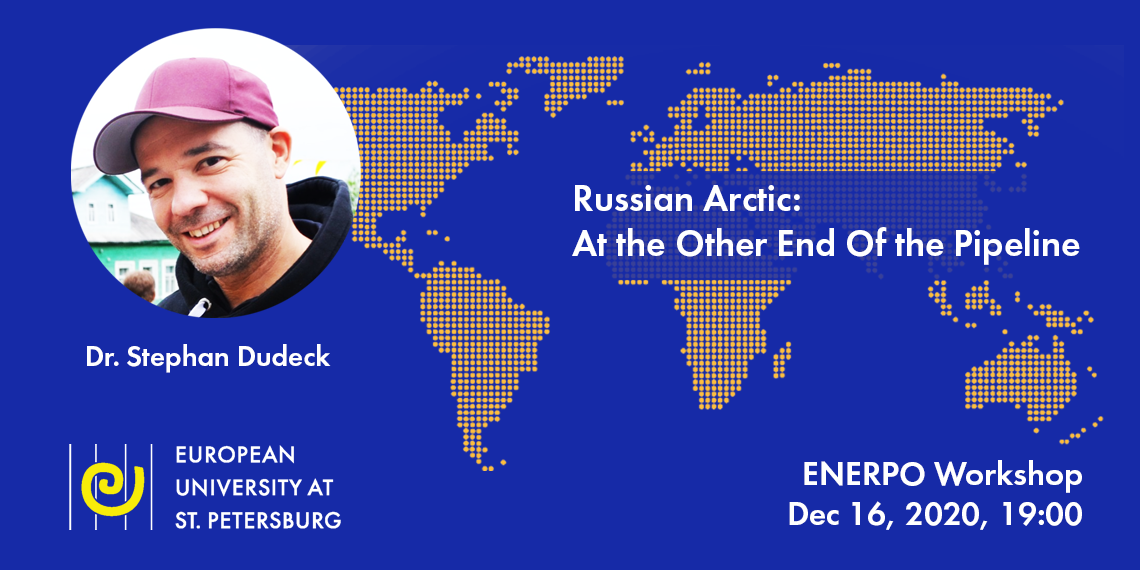

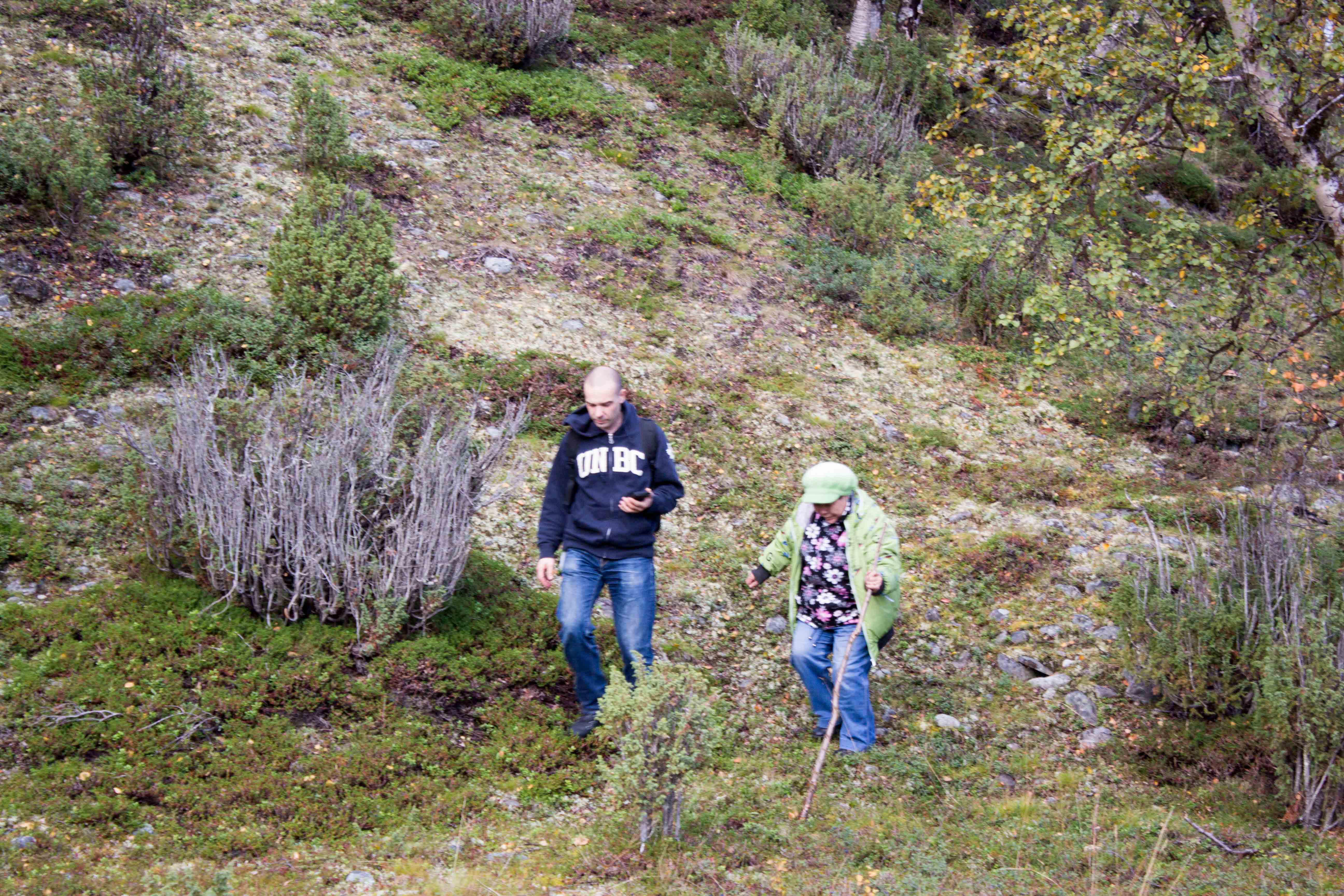
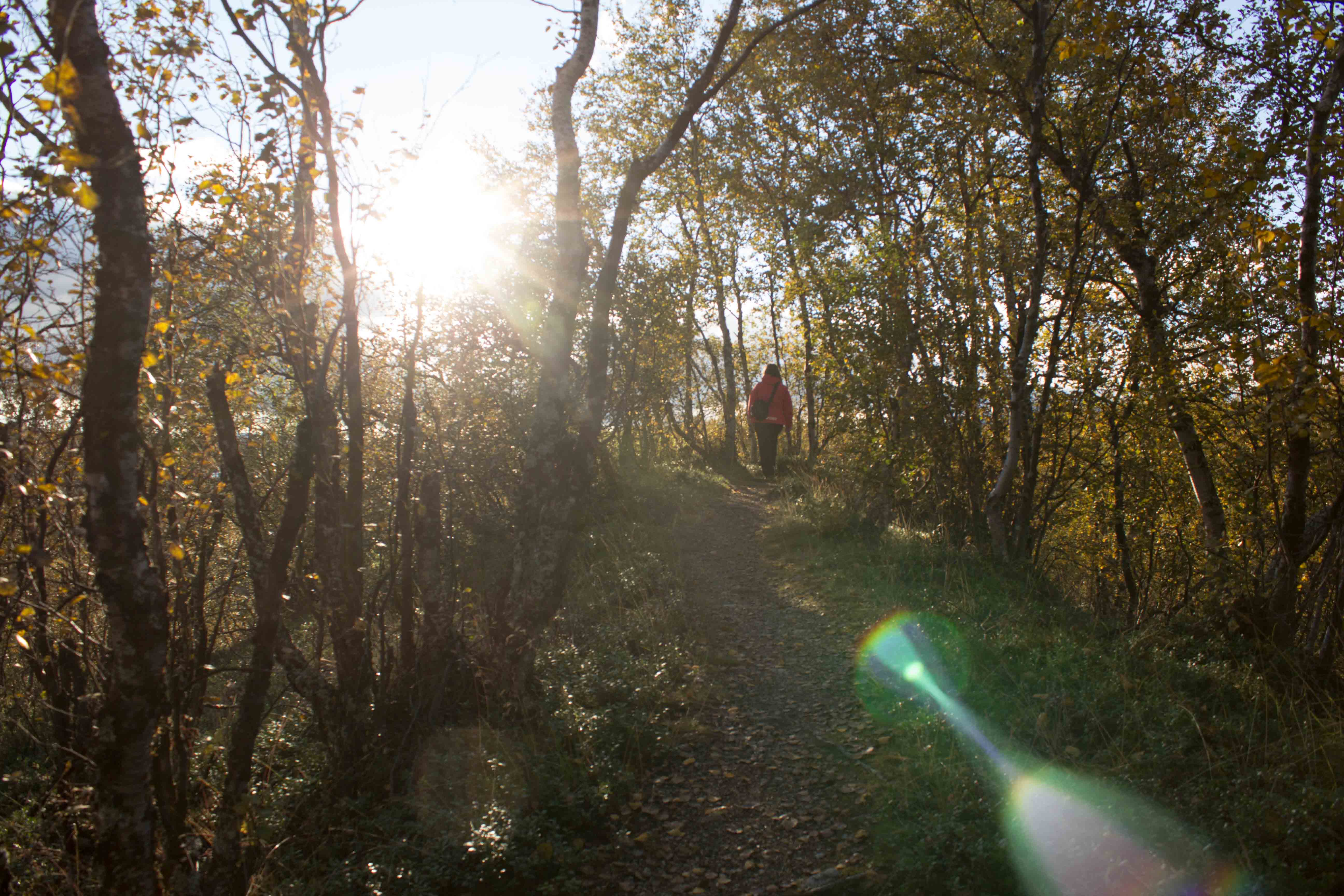 But first we took a stop at the Suttesaja spring and had a little hike. At recommendation of my colleague Philipp Burgess, I read an article about the struggle of local Sámi to protect the spring from being turned into a
But first we took a stop at the Suttesaja spring and had a little hike. At recommendation of my colleague Philipp Burgess, I read an article about the struggle of local Sámi to protect the spring from being turned into a 


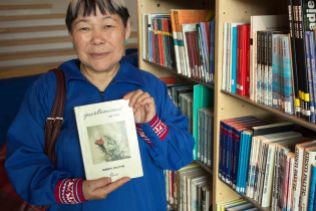








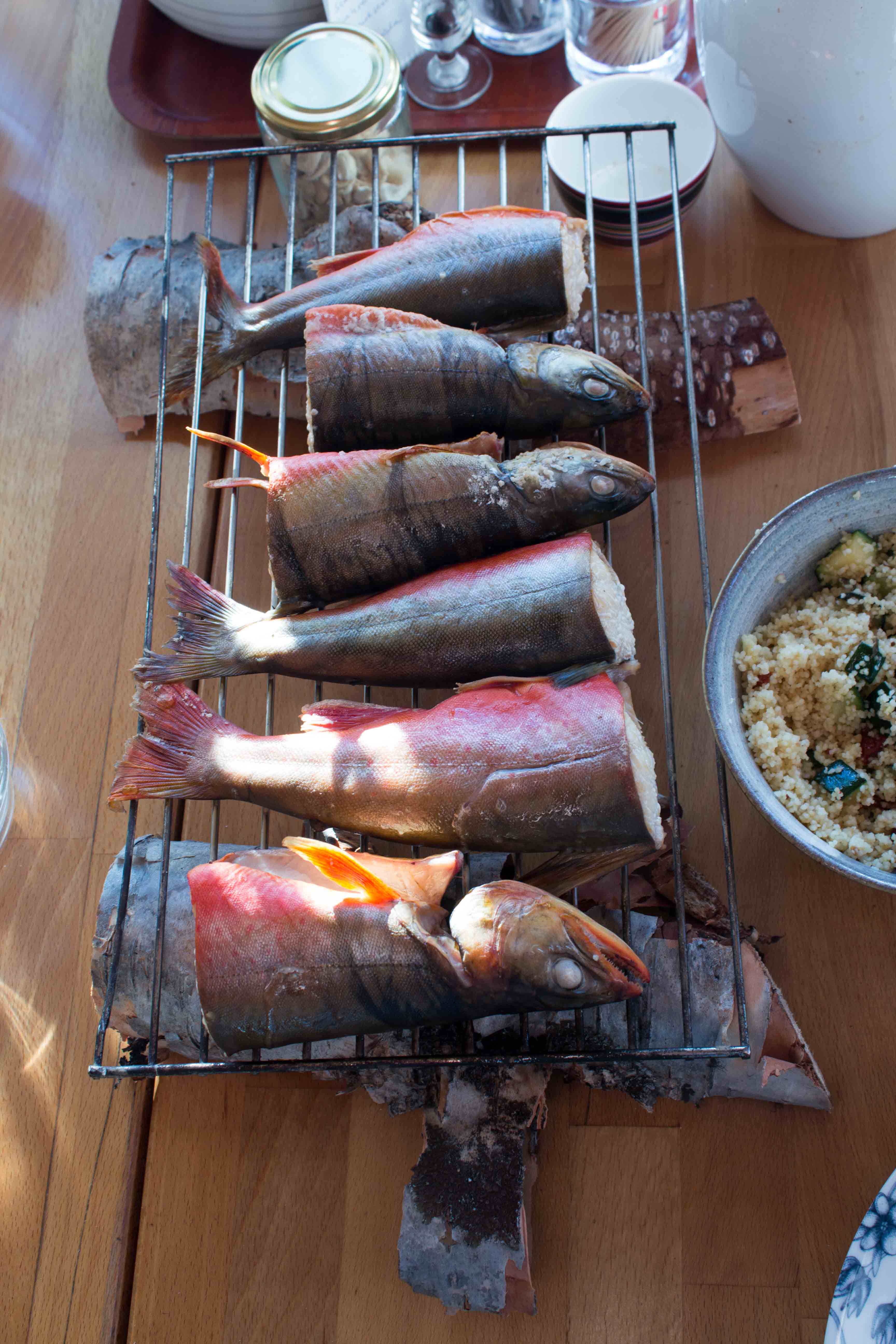 It was almost like an artistic composition – the place, the light of the sunset, the food and the conversations on indigenous views, on Johan Turi and Nils-Aslak Valkeapää, Oulas uncle.
It was almost like an artistic composition – the place, the light of the sunset, the food and the conversations on indigenous views, on Johan Turi and Nils-Aslak Valkeapää, Oulas uncle.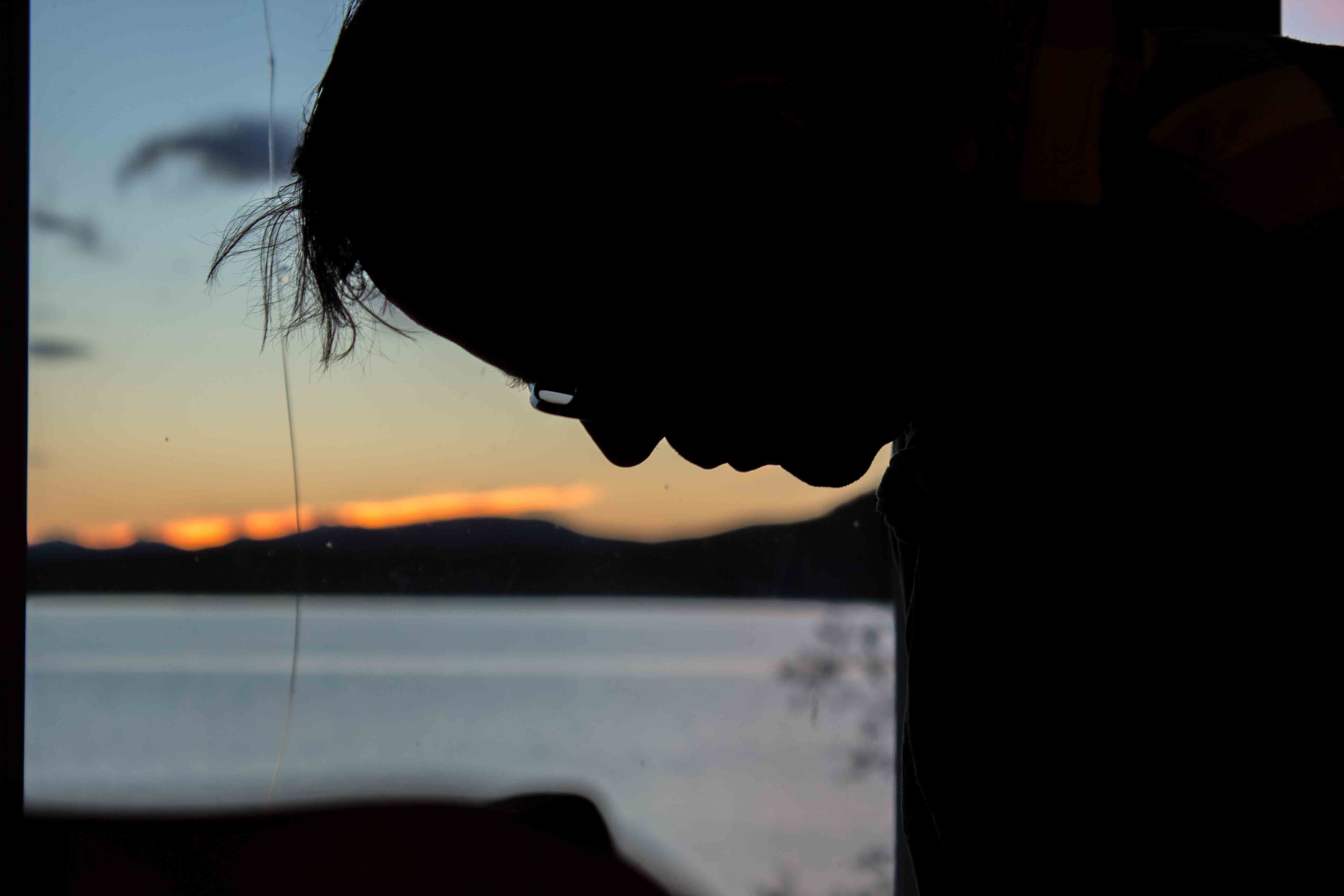
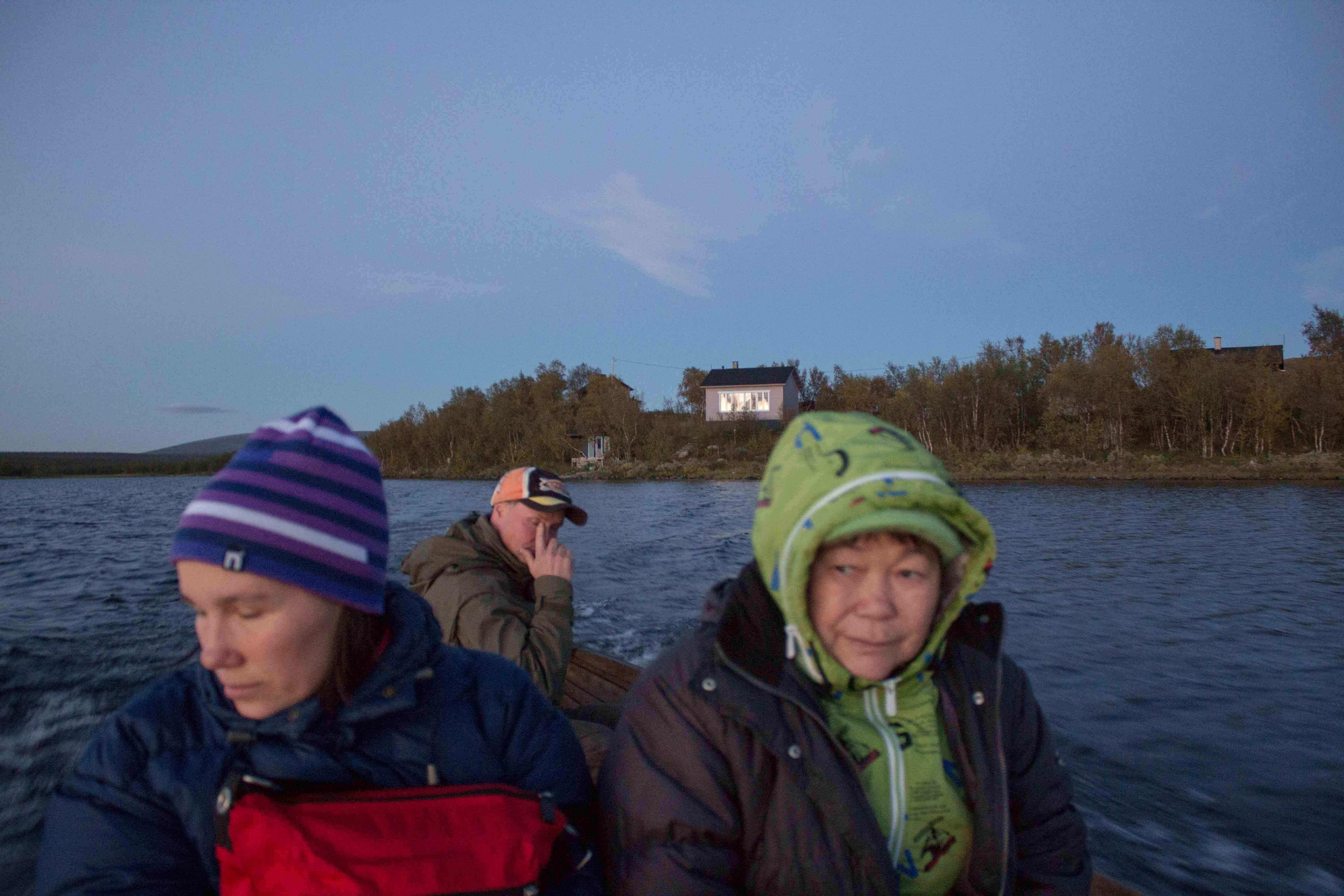



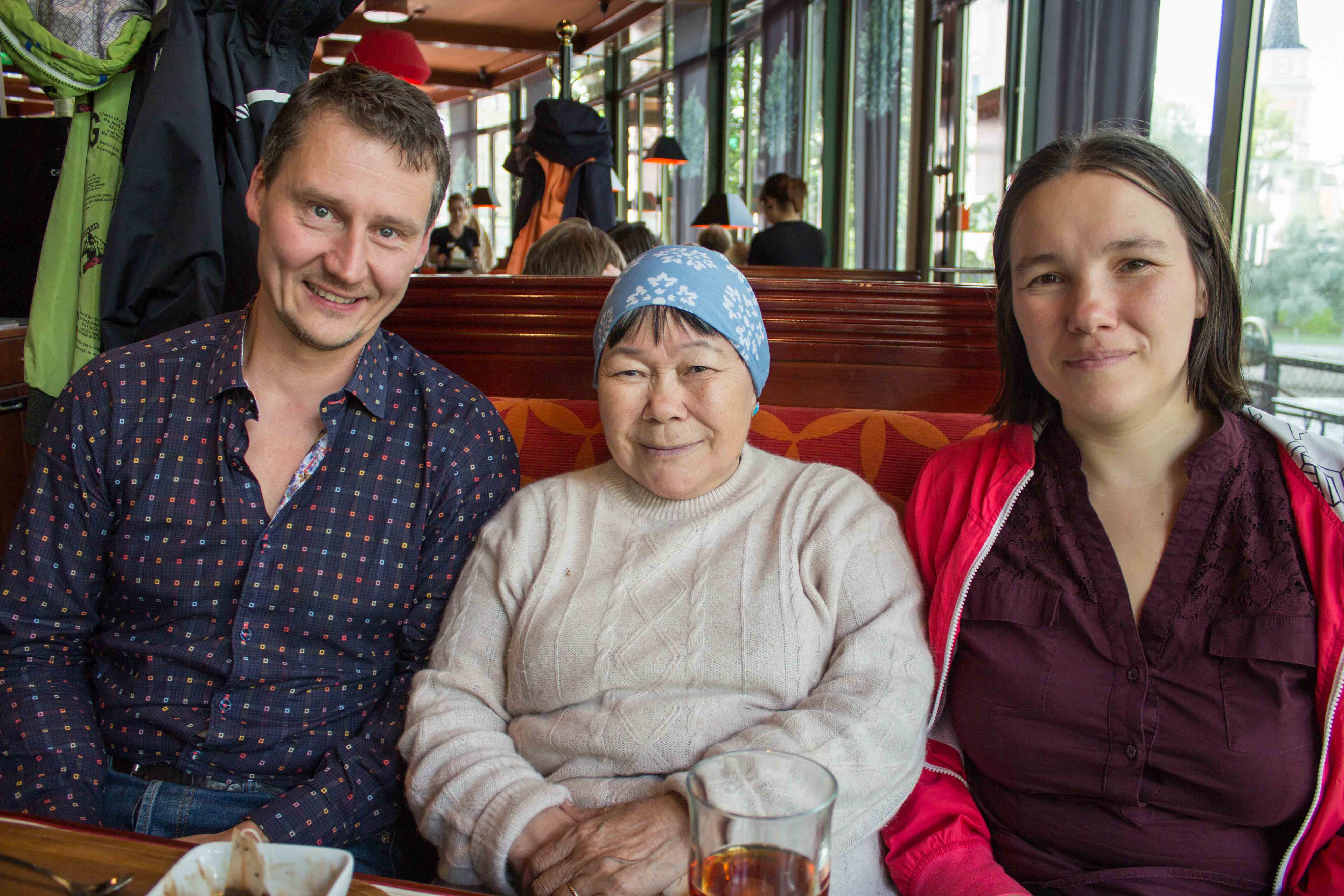












 Everybody was impressed, what the chefs were able to produce from local ingredients like reindeer lichen. But more important were the discussions about similar issues Sámi as well as Khanty are facing today. Liisa Holmberg told about the international cooperation on the protection of sacred sites. In Sápmi sacred sites are either long time known places partially turned already into tourism destinations, as the sacred island
Everybody was impressed, what the chefs were able to produce from local ingredients like reindeer lichen. But more important were the discussions about similar issues Sámi as well as Khanty are facing today. Liisa Holmberg told about the international cooperation on the protection of sacred sites. In Sápmi sacred sites are either long time known places partially turned already into tourism destinations, as the sacred island  Probably the main purpose and highlight of the visit to Inari was a short but intensive visit of the material in the Sámi archive collected at the beginning of the 1990ies among the Surgut Khanty. These materials, like the ones that were recorded by Lennart Meri and preserved in Estonia, will hopefully return to the Khanty one day. But it is important that the efforts to make them available respect the ethics of knowledge distribution as well as access rules of the indigenous people they were collected from. We got the strong impression during our meeting with Inker-Anni Linkola and Ugnė Starkutė that here at the Sámi archive these principles are held in high esteem and it is one of the rare examples, where high quality archival work is combined with indigenous perspectives on knowledge transmission and information management.
Probably the main purpose and highlight of the visit to Inari was a short but intensive visit of the material in the Sámi archive collected at the beginning of the 1990ies among the Surgut Khanty. These materials, like the ones that were recorded by Lennart Meri and preserved in Estonia, will hopefully return to the Khanty one day. But it is important that the efforts to make them available respect the ethics of knowledge distribution as well as access rules of the indigenous people they were collected from. We got the strong impression during our meeting with Inker-Anni Linkola and Ugnė Starkutė that here at the Sámi archive these principles are held in high esteem and it is one of the rare examples, where high quality archival work is combined with indigenous perspectives on knowledge transmission and information management. Tourism and handicraft production for a touristic audience is nowadays an important part of Sámi livelihoods. The level of craftsmanship or better say craftswomanship is high as we were able to satisfy ourselves. Marina drove us to the gallery
Tourism and handicraft production for a touristic audience is nowadays an important part of Sámi livelihoods. The level of craftsmanship or better say craftswomanship is high as we were able to satisfy ourselves. Marina drove us to the gallery  and to the studio of
and to the studio of 
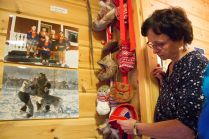
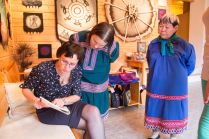
 Whoever we met among the Sámi was amazed of the laboriously Khanty ornaments cut and sewn by hand without any technical tools.
Whoever we met among the Sámi was amazed of the laboriously Khanty ornaments cut and sewn by hand without any technical tools.

 The day before we met already Sámi singer Nilas Holmberg at the hotel Kultahovi and he suggested us not to miss the concerts of the Sámi music festival “Ijahis idja”.
The day before we met already Sámi singer Nilas Holmberg at the hotel Kultahovi and he suggested us not to miss the concerts of the Sámi music festival “Ijahis idja”. The highlight was of course Sofia Jannok, Sámi singer from Sweden. Waving the Sámi flag and wearing an army jacket underlined her performance as a straightforward statement for active and militant struggle for indigenous rights. She cited even the movie “Avatar” as a model for her perception of indigenous history.
The highlight was of course Sofia Jannok, Sámi singer from Sweden. Waving the Sámi flag and wearing an army jacket underlined her performance as a straightforward statement for active and militant struggle for indigenous rights. She cited even the movie “Avatar” as a model for her perception of indigenous history. Next day we met the president of the Sámi parliament Tiina Juulia Sanila-Aikio or
Next day we met the president of the Sámi parliament Tiina Juulia Sanila-Aikio or  Maybe the title president implies to follow a protocol and a formalised way of meeting. This was not at all the case. At the opposite – the Sámi president is just a highly skilled professional on the issues the parliament is dealing with today.
Maybe the title president implies to follow a protocol and a formalised way of meeting. This was not at all the case. At the opposite – the Sámi president is just a highly skilled professional on the issues the parliament is dealing with today. When Tiina Sanila-Aikio brought us to the exhibition room Agrafena was overwhelmed of the variety in the collection of schoolbooks in Sámi languages.
When Tiina Sanila-Aikio brought us to the exhibition room Agrafena was overwhelmed of the variety in the collection of schoolbooks in Sámi languages. Here some links to the”
Here some links to the”

 After their performance Marija and Agrafena gave a
After their performance Marija and Agrafena gave a 


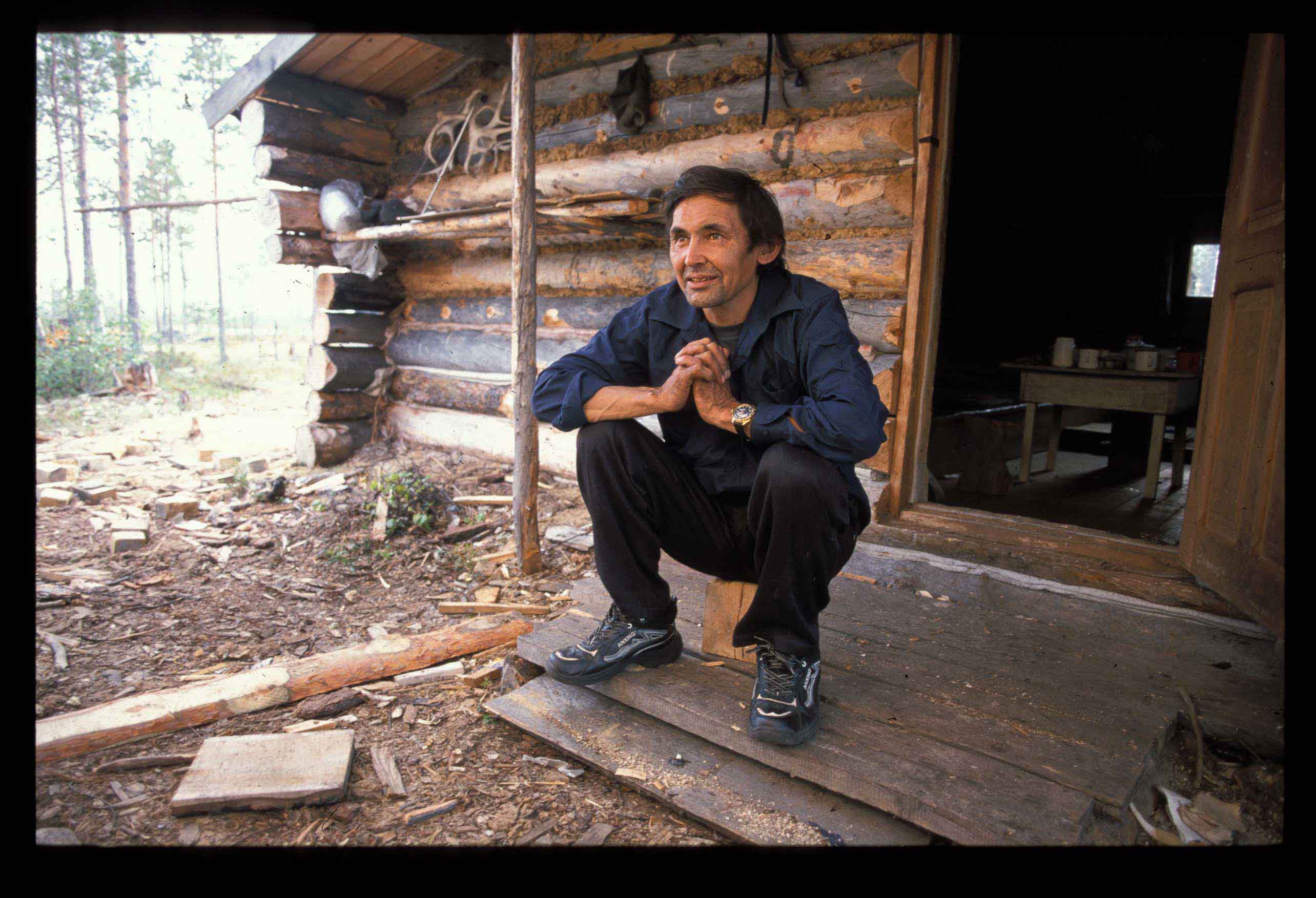
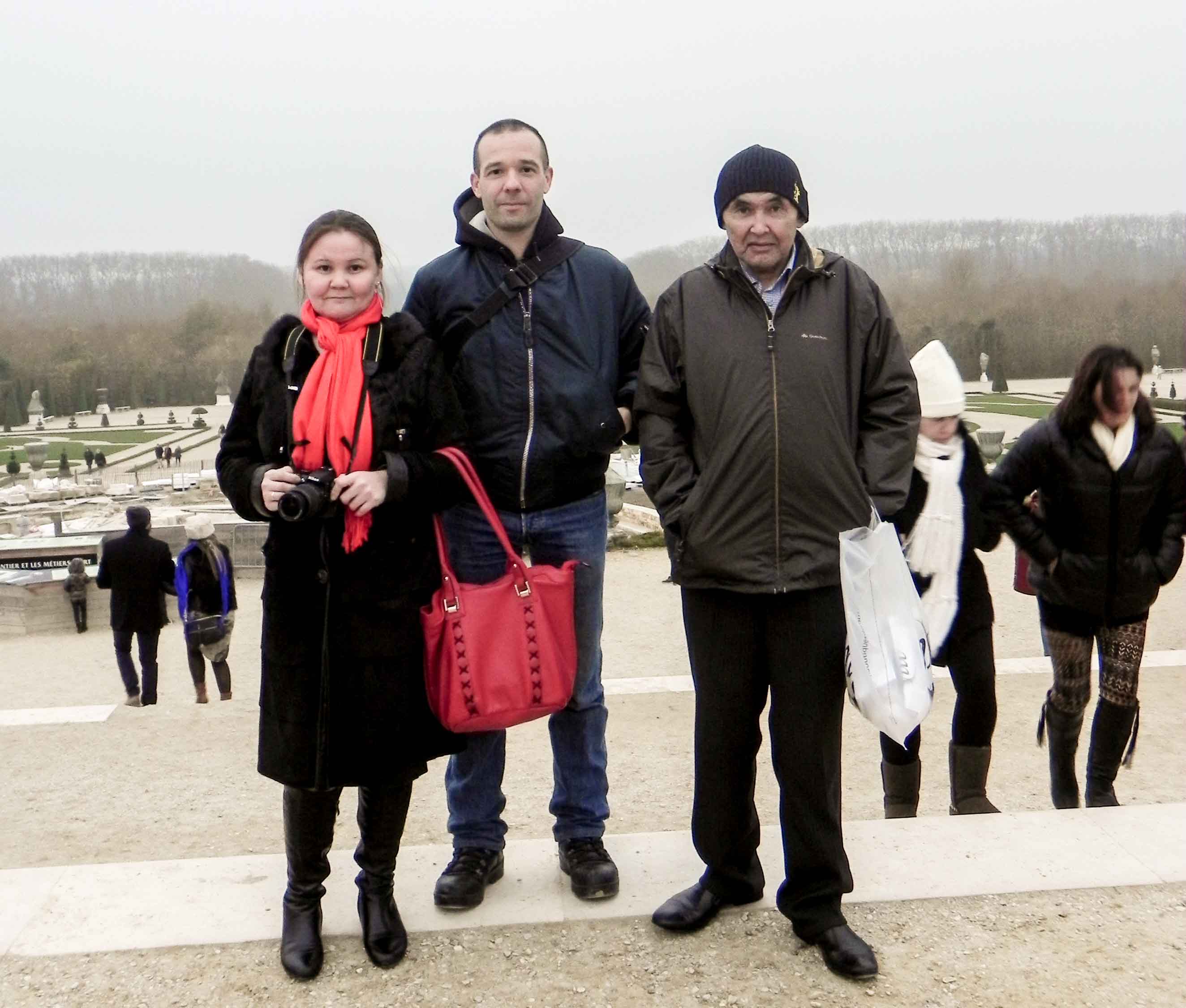
 The last time I met Iosif Nikitovich was in early April of this year. He was attending the Day of the Reindeer Herder in the town of Kogalym with his family, his wife Sveta, daughter Nelya, his son Volodya and his grandchildren Dima and Zhenya. I did not expect it would be last time I would see him. He explained to me why he hadn’t performed some days prior at the
The last time I met Iosif Nikitovich was in early April of this year. He was attending the Day of the Reindeer Herder in the town of Kogalym with his family, his wife Sveta, daughter Nelya, his son Volodya and his grandchildren Dima and Zhenya. I did not expect it would be last time I would see him. He explained to me why he hadn’t performed some days prior at the 

 Iosif Nikitovich Kechimov left us much too early at the age of 56. Unfortunately, he is not an exception among the Khanty of the Khanty-Mansi Autonomous Region where Russia produces more than half of its oil. Social marginalisation, the poisoned environment where the Khanty fish, collect berries and obtain their drinking water, and the reindeer search for nourishment, and and the stress of an unsecured future all lead to the low life expectancy of the indigenous Khanty, Nenets and Mansi in the region, an estimated 10 years below the Russian average.
Iosif Nikitovich Kechimov left us much too early at the age of 56. Unfortunately, he is not an exception among the Khanty of the Khanty-Mansi Autonomous Region where Russia produces more than half of its oil. Social marginalisation, the poisoned environment where the Khanty fish, collect berries and obtain their drinking water, and the reindeer search for nourishment, and and the stress of an unsecured future all lead to the low life expectancy of the indigenous Khanty, Nenets and Mansi in the region, an estimated 10 years below the Russian average.
